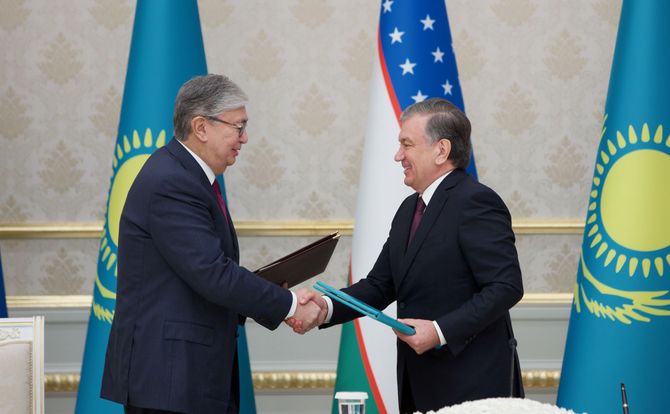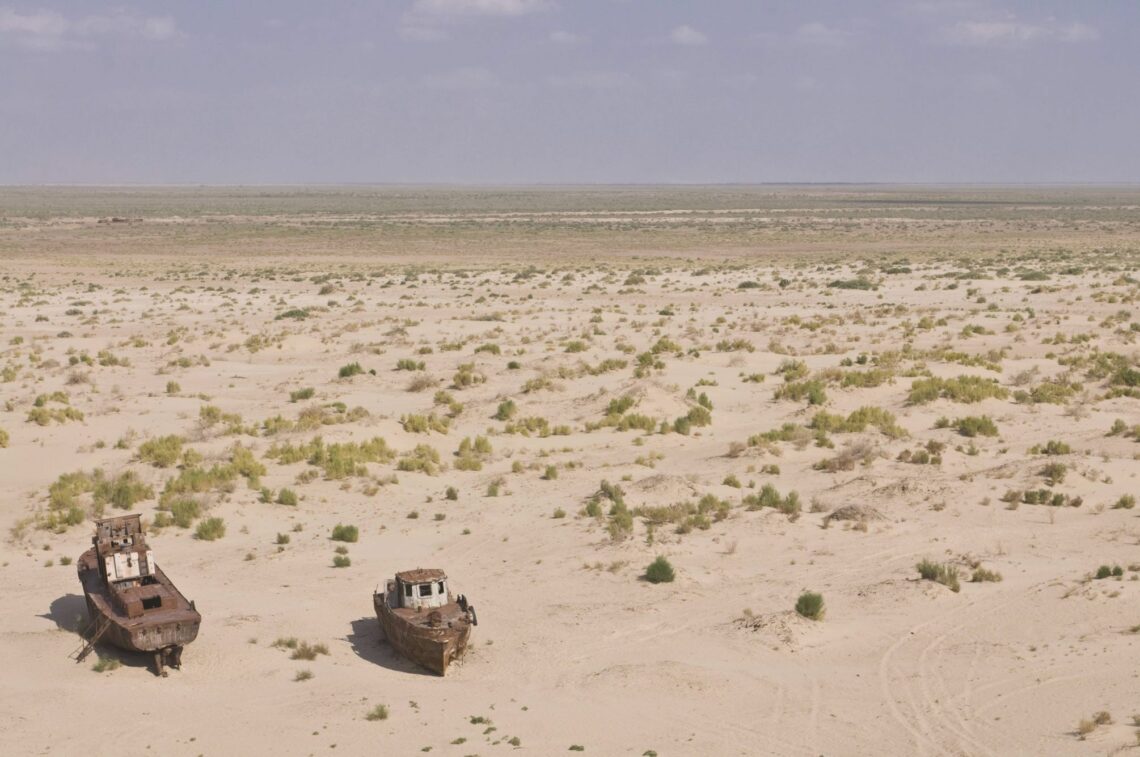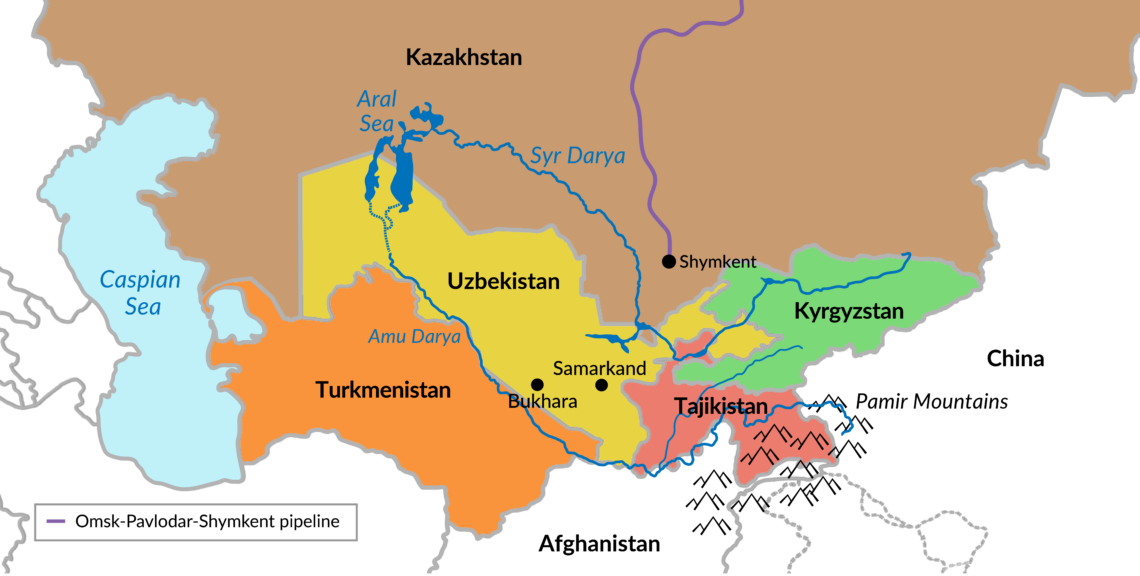Shifting power in Central Asia
Central Asian countries have been considered theaters for great power competition, not players on the geopolitical chessboard in their own right. However, these nations begin to resolve their differences and enhance their strengths. They have much to gain, but Soviet-era divisions and economic imbalances remain deeply rooted.

In a nutshell
- Central Asia’s leaders are making moves to increase their autonomy
- If the countries cooperate, it could bring substantial economic benefits
- Their biggest challenge will be to resolve disputes born of Soviet-era policies
Ever since the days of the 19th-century “Great Game” between the Russian and British empires, Central Asia has been seen as a playing field where outside powers test their strength. During the close to three decades that have passed since the collapse of the Soviet Union, the region has witnessed battles for control over energy resources, security ramifications of the United States’ campaign in Afghanistan, and the rollout of the Chinese Belt and Road Initiative (BRI). Throughout this period, outside accounts have remained beholden to the view of the region as a passive arena.
Recent developments suggest that such perceptions may need revision. As analysts speculate about the conflicting regional agendas of China and Russia, local leaders are making autonomous moves that may have geopolitical implications. The stakes are high.
A joint study by the United Nations Development Programme and the Asian Development Bank recently found that more effective regional cooperation might lead to a doubling of Central Asia’s gross domestic product (GDP). Recent regional summits have been held without Russian participation, seeking to drive home that local leaders can solve their own problems. Beijing and Moscow are united in looking with disfavor at the ambitions of these nations to widen their options by reconnecting with Europe and the U.S.
Soviet legacy
Although outside powers will remain important in shaping developments, a deeper understanding of their respective prospects requires more attention to how players inside the region are developing proactive strategies, aimed at strengthening regional ties. They face challenges connected with overcoming the divisive historical legacy of Russian overlordship, which has often precluded cooperation. The most immediate concerns borders.
Stalin deliberately sowed the seeds for the troubles that have caused so much conflict.
The region’s national composition is rooted in the tribal structure of the Mongol Golden Horde, intermixed with nomadic Turkic peoples. When the Russian Empire expanded into the region, it was incorporated as “Turkestan,” ignoring the presence of Persian Tajik elements. When Joseph Stalin subsequently divided it into five Soviet republics (SSRs), he deliberately sowed the seeds for the troubles that have caused so much conflict in recent decades.
Eminent centers of ancient Persian culture like Samarkand and Bukhara were assigned to the Turkic Uzbek SSR rather than the Persian Tajik SSR. Borders between the Uzbek, Kyrgyz and Tajik SSRs were drawn in complex meandering patterns that deliberately maximized local border conflicts; large ethnic exclaves were created in neighboring republics. If these complex issues can be amicably settled, the region will have come a long way toward autonomy, stability and potential prosperity.
Another challenge is water management. The flow of water into the region comes from two rivers originating in the Pamir Mountains – the Amu Darya and the Syr Darya. During the Soviet era, that water was used to support huge cotton plantations, mostly in Uzbekistan. The irrigation was so wasteful that the Aral Sea, once the fourth-largest lake in the world, has now lost 90 percent of the water volume it had in the 1960s, effectively destroying local fisheries.

Compounding the problem, a 300-meter-tall hydropower dam was built at Nurek in Tajikistan. Completed in 1980, it was the tallest dam in the world, designed to produce 2,700 megawatts of electricity and to irrigate 650,000 hectares of farmland. More recently, Tajikistan has begun building a second dam at Rogun, close to Nurek. At 335 meters, it will be the highest dam ever built. As downstream neighbors express concern about implications for their cotton growing, the need for confidence building is increasing.
A third challenge concerns Russification, entailing exclusive official use of the Russian language and intimate links with educational establishments in Russia. This legacy has given Russia a substantial advantage over other outside powers. Recent moves to abandon the Cyrillic alphabet and to downgrade the role of the Russian language have combined with the growing influence of pan-Turkism to alter how peoples in the region see themselves. The formation of new regional identities would represent a big step toward enhancing the autonomy of these nations.
Uzbek-Kazakh reconciliation
The main question is whether effective regional cooperation can really emerge. The geopolitical implications could be substantial, ranging from a fading interest in the BRI and in Russia as a security provider, to a reenergized role for Europe and the U.S. in supporting market development. Success hinges on fostering a sense of trust among the five countries’ leaders – especially those of Uzbekistan and Kazakhstan.
The trigger for the transformations that are currently underway was the death in 2016 of Uzbek strongman President Islam Karimov, who had held power for nearly three decades. During the Soviet era, Tashkent had been considered the most influential city and Uzbekistan the leading power in Central Asia. But following the proclamation of independence, President Karimov adopted an erratic leadership style that led to isolation and loss of influence.
The main question is whether effective regional cooperation can really emerge.
In consequence, the role of leading regional power went to Kazakhstan and its long-serving strongman, President Nursultan Nazarbayev. With a budget supported by petro-wealth from huge oil discoveries, he cultivated good relations with the U.S. and excellent relations with Russia. Kazakhstan was a founding member of the Customs Union that morphed into the Eurasian Economic Union. The partnership between Moscow and Astana – recently renamed Nur-Sultan – has been a key fixture in Eurasian politics.
At the time of Mr. Karimov’s death, speculation had long been rife that a bitter succession struggle would follow, and that militant jihadi forces like the Islamic Movement of Uzbekistan (IMU) might rise to power. To the great surprise of outside observers, the political elites achieved an orderly transition. The new president, Shavkat Mirziyoyev, introduced an ambitious program for domestic reform that has won accolades from economic observers. He also embarked on a successful foreign policy to mend fences with neighbors.
President Mirziyoyev’s state visits to Tajikistan and Kyrgyzstan in 2017 and 2018 dispelled anger over Uzbek involvement in their respective civil wars in the 1990s. In return, his administration laid to rest complaints about those countries providing a safe haven for militant Islamists, and began removing landmines placed on the border in response to earlier incursions by IMU militants. It proclaimed that the Rogun dam was no longer a problem in relations with Tajikistan and concluded an agreement with Kyrgyzstan to amicably settle demarcation of 85 percent of the countries’ common border. Agreements on relaxed visa regimes have contributed to increased trade.
While the creation of good relations with the smaller neighbors has been important enough, the real prize for Mr. Mirziyoyev is mending fences with Kazakhstan. With a population of 33 million, compared with 18 million in Kazakhstan, Uzbekistan is the most populous country in the region, and it has the largest security forces. Yet, following a long, self-imposed isolation, it lacks the human capital to capitalize fully on economic reforms. By far the richest of the five countries in the region, Kazakhstan has both the know-how and the economic resources to provide regional leadership, and to support Uzbekistan’s rapid development.
Facts & figures
Central Asia: Burgeoning cooperation

The main challenge is whether an Uzbek resurgence can be accommodated amicably. So far, things are going well. Mutual cultural and humanitarian relations are being developed; 2018 was the year of Uzbekistan in Kazakhstan, and 2019 is the year of Kazakhstan in Uzbekistan. More substantively, bilateral Uzbek-Kazakh trade increased by 47 percent in 2018, reaching $3 billion.
Energy cooperation is a case in point. Responding to major oil discoveries in the 1990s, Uzbekistan built oil refineries with an annual capacity of 11 million tons. As many of the new fields have dried up, those refineries are now forced to operate at half capacity. Russia has responded by shipping oil, and Kazakhstan stands ready to do the same. Having shipped no more than 260,000 tons to Uzbekistan in 2018, the Kazakh government said it is now ready to ship 2 million tons to its neighbor. The figure should eventually rise to 5 million tons. The crux is that this will require expanding the Omsk-Pavlodar-Shymkent pipeline into Uzbekistan.
Looking beyond economic cooperation, the main feature of the transformation has been to hold regional summits without Russia. In March 2018, President Nazarbayev hosted four of the five regional leaders for a meeting that focused on boosting trade and on sharing water resources. He noted that the initiative had come from President Mirziyoyev, that there was a new atmosphere in relations, and that he anticipated further annual meetings to resolve common problems without “outside mentors.” Although Turkmenistan abstained from taking part at the presidential level, in August 2018 all five leaders met in Turkmenistan to discuss Aral Sea issues.
Cooperation with the West
If the new atmosphere of cooperation between Uzbekistan and Kazakhstan continues, then the possibility that the region’s GDP could double might lure Europe and the U.S. into reengagement. The Uzbek-Kazak tandem has embarked on assertive diplomacy to make this happen. President Nazarbayev visited Washington in January 2018 and President Mirziyoyev followed suit in May. A reengagement agenda focused on business and investment, and which downplays human rights and democratic governance issues, could succeed. U.S. and EU leaders have responded positively.
The main feature of the transformation has been to hold regional summits without Russia.
Following President Nazarbayev’s visit to Washington, the State Department announced an “Enhanced Strategic Partnership” with Kazakhstan, designed to “strengthen cooperation on political and security issues, trade and investment.” During a visit to Tashkent in January this year, EU special representative Peter Burian said the EU welcomes the new regional policy and is ready to use its full range of assistance – technical assistance, grants and other tools. Its new strategy for cooperation with Central Asia will reflect the leading role of Uzbekistan in regional integration.
One reason to take these initiatives seriously is that the BRI is losing its luster. The quality of construction work on some of its infrastructure projects may not have been up to par. Investment is being scaled back, and concern over Beijing’s predatory lending practices is mounting. Resentment of Chinese influence has risen as persecution of the Muslim Uighur population in Xinjiang has spilled over to ethnic Kazakhs and Kyrgyz.
Moreover, despite its recent surge in investment in Uzbekistan, Russia’s profile in Central Asia is fading. The role of the Russian language is being scaled back. By taking a stand against the persecution of the Uighurs, Turkish President Recep Tayyip Erdogan has created more room for his policy of pan-Turkism. And reference to the threat of Islamist incursions from Afghanistan no longer provides the same support for Russian weapons sales.
Lingering doubts
This said, there are several reasons why hopes of a regional transformation may need to be scaled back. One concerns whether U.S. and European companies really are interested in reengaging. Although the U.S. military remains convinced of the need to cooperate with Uzbekistan, private enterprises worry about the public relations impact of human rights abuses and about the danger of teaming up with partners that work with Russian companies and may be subject to sanctions.
An even bigger question is whether the five countries can really maintain sufficient cohesion to capitalize on an economic revival. While Uzbekistan has scored real successes, Turkmenistan still must emerge out of its neutrality, and relations between Kazakhstan and Kyrgyzstan remain frosty.
Shortly before its 2017 presidential election, Bishkek accused Astana of ‘meddling’ in its internal affairs.
Shortly before its 2017 presidential election, Bishkek accused Astana of “meddling” in its internal affairs. Outgoing President Almazbek Atambayev lashed out at President Nazarbayev, suggesting his regime was “embezzling” his nation’s riches, and even rescinded an agreement to receive a $100 million subsidy from Kazakhstan, designed to help Kyrgyzstan adapt to the standards of the EEU.
The response from Astana was border inspections that caused hours-long delays for people and vehicles trying to cross into Kazakhstan. And it accused Kyrgyzstan of tolerating a multibillion-dollar smuggling network. Although President Nazarbayev has adopted a more conciliatory tone toward the new president, Sooronbay Jeenbekov, the problems have not been fully resolved. In April 2019, Kyrgyz trucks were again standing idle on the border.
The creation of regional identities also requires further success in resolving complex border issues. The Uzbek-Kyrgyz case represents real progress, defusing long-standing tensions over minorities that have resulted in clashes between locals and border guards. Talks are underway on further border demarcations that may range from land swaps and corridors to visions of free travel. But some 15 percent of the border remains to be settled, and latent hostilities may still flare up.
An even more tangible threat to the vision of a regional economic boom lies in huge urban-rural divides and in collapsed social welfare networks. Deepening poverty implies that governments not only become heavily reliant on remittances from labor migrants. They also face the risk of migrants becoming radicalized abroad, enhancing the threat to regional security and playing into the hands of Russia as a regional security provider.
While these caveats suggest that hopes for a doubling of regional GDP and a reenergized presence of the EU and the U.S. may need to be reined in, there is still sufficient evidence to suggest that the region is being transformed, that closer cooperation between Kazakhstan and Uzbekistan will have an impact on trade and security relations, and that both Beijing and Moscow will find tougher regional resistance to their respective agendas.







